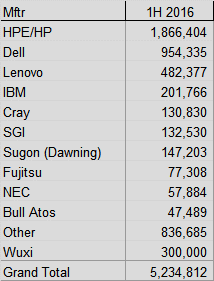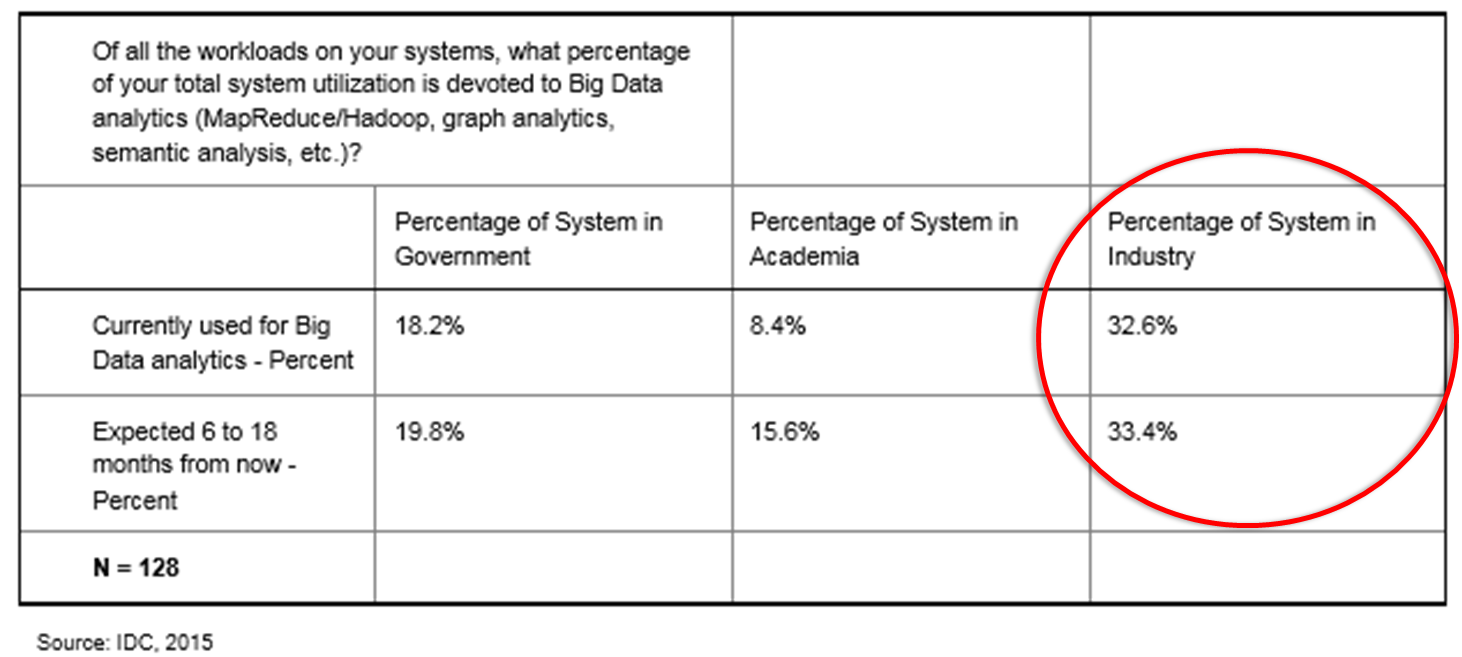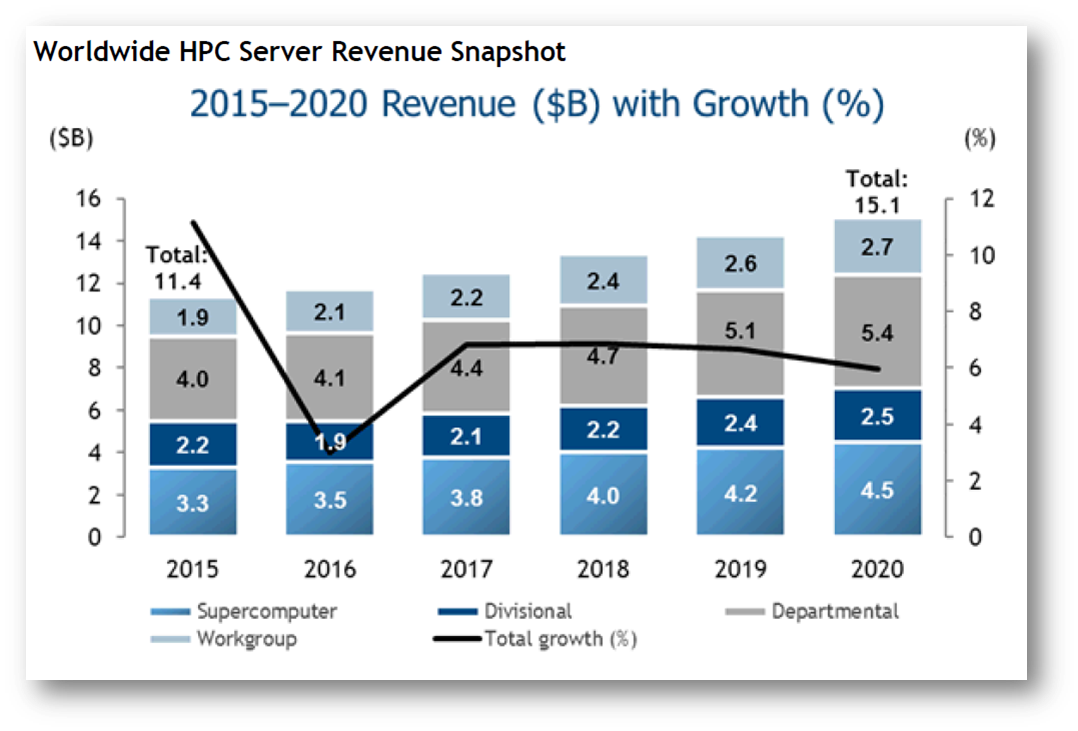The rapid growth in technology that can be trained, that infers, that continually learns from information contained in enormous data sets, all the while generating strong ROI on strategic initiatives, dominated ICD’s annual HPC market report presented yesterday at SC16 in Salt Lake City.
“High performance data analytics (HPDA) is where Big Data and HPC come together,” said Earl Joseph, IDC program vice president, high-performance computing, “and we’re seeing some tremendous growth in this area. Big Data is having major impact on HPC and we expect it to be one of the fundamental growth drivers.”

Overall HPC purchases in 2015 totaled $11.4B, IDC reported, for a growth rate of more than 10 percent, with storage the fastest growing segment. Cyclically “bumpy” supercomputer sales declined as purchases of top 10 systems slowed for the third straight year, but IDC noted “the profusion of Exascale announcements is generating a lot of buzz,” and Joseph said supercomputer sales are expected to experience a significant uptick in 2017.
Meanwhile the overall HPC server market (ranging from supercomputers to workgroup systems) totaled $5.2 billion for the first half of the year with 2016 “looking good,” Joseph said, projected at 6 to 7 percent growth.
IDC expects the HPC server market to continue to average annual 6 percent growth through 2020.
Some of the most impressive findings released by IDC were updates to its HPC ROI study, developed as part of a DOE grant and based on data from 673 HPC installations in 14 countries across government, academic and industry. On average, according to IDC, every dollar invested in HPC generated $551 in revenues and $52 in profits or cost savings.
“These are tremendous returns compared to normal venture capitalists and everyone else,” Joseph said, “and a big part of this is because HPC is often applied to very successful and big projects and programs.”
IDC also measured HPC-related job creation, finding that the overall average HPC investment cost per job created was $270K.
 As for vendor competition, IDC reported that during the first half of 2016 HPE had nearly twice the HPC server revenues, $1.9B, of its closest rival, Dell, at $954 million. In the supercomputer segment, HPE had revenues of $446 million to Dell’s $224 million.
As for vendor competition, IDC reported that during the first half of 2016 HPE had nearly twice the HPC server revenues, $1.9B, of its closest rival, Dell, at $954 million. In the supercomputer segment, HPE had revenues of $446 million to Dell’s $224 million.
“HPE clearly has become the market leader when IBM sold of its x86 assets to Lenovo,” said Joseph. “But going forward with the acquisition of SGI, it really puts them in a different position from the other vendors. We’re also seeing Dell having significant growth right now, and with the combination with EMC we expect to see Dell’s growth move up quite a bit.”
It’s the ongoing confluence of big data with HPC that is a primary driver of HPC adoption in new and expanding markets, Joseph said.
Identifying the major sectors within the HPDA category has been an ongoing exercise. Currently, IDC singles out four HPDA segments:
- Security, fraud and anomaly detection. This centers around identifying potentially harmful patterns and causes using graph analysis, semantic analysis or other high performance analytics techniques. The patterns may point to fraud or to cyber security crime or insider threats, significant errors, or other anomalies.
- This is the use of HPDA to promote products or services, typically using complex algorithms to discern potential customers’ demographics, buying preferences and habits.
- Business intelligence. This workload segment uses HPDA to identify opportunities to advance the market position and competitiveness of businesses, by better understanding themselves, their competitors, and the evolving dynamics of the markets they participate in.
- Other commercial HPDA. This includes all other commercial HPDA, such as high-potential workload to manage large IT infrastructures, ranging from on premise data centers to public clouds and Internet-of-Things (IoT) infrastructures.
Joseph noted that the next new HPDA segment will be precision medicine, in which a patient’s individual genome, history and symptomology are stored in a database and compared with millions of archived patient records for relevant outcomes.
“We expect HPDA, machine learning and AI to really have some substantial growth in the market,” Joseph said. “We’re talking to so many clients about how to use HPC in these new unique ways. And the market factor that’s amazing to me is that the financial returns are just staggering. It’s a place where people aren’t as concerned with how cheap the system is, how cheap the software is, it’s much more about solving a strategic problem that’s going to generate a lot of revenue.”
Steve Conway, IDC research vice president, high performance computing, said he and his colleagues look closely at “what triggers people to add HPC into their enterprise IT data centers. And it’s the fact of complexity and time criticality that make that happen.”

IDC projects HPDA server market growth through 2020 of 26 percent CAGR in new commercial analytics segments, compared with 17 percent CAGR for traditional HPC server segments. The overall HPDA market will grow robustly to $3.9B by 2018, with the strongest growth is taking place in industry, where it is “taking off like a rocket,” said Conway. As of 2015, IDC reported, more than 33 percent of workloads in commercial settings over the next six to 18 months will be devoted to HPDA; whereas in government and academia HPDA workloads are expected to be 20 and 16 percent, respectively.

Bob Sorensen, IDC research vice president, HPC group, said the “HPC universe is expanding in ways that are not directly observed…because we haven’t quite decided what the definition of HPC should be.”
He identified work being done with new hardware and software for deep learning. “From the training phase, the computationally intensive part where you go and train a deep neural network to understand a tough problem – exaflops regression kind of training,” involving GPUs, (Xeon) Phis and FPGAs.
He also cited “tactical HPC for inference,” the use of a subset of a system that was trained on a larger HPC system. “It could be questions as trivial as your smart phone being able to understand your voice or as relatively computationally complex” as a self-driving car.”
“There are companies out there adopting business intelligence, who are being forced into HPC simply because their data sets are growing,” Sorensen said. “They don’t have the luxury of saying ‘Wow, we’ve got all this additional data, let’s just ignore it because we don’t have the computational capability to handle it.’ The growth in the data that’s available to these companies is forcing them into the HPC world, whether they like it or not.”
He said the next major development in deep learning is what Sorensen called “on the job training” – an application becoming smarter as it carries out its tasks. “You have a car that’s driving down a street and comes across a problem it hasn’t seen before. And if it reacts badly or properly, that information is then communicated to the entire community of cars that are using that same inference engine. It’s a merging of training and inference.”
At the breakfast, IDC also announced the 10th round of recipients of the HPC Innovation Excellence Award. This year’s winners are:
Robert Wilhelmson and Leigh Orf, University of Wisconsin at Madison: “Unlocking the Mysteries of the Most Violent Tornadoes.” The researched studied devastating, long-lived tornadoes, which are rare but the death and destruction they cause is significant. This computational project reviewed nearly four years of the researchers’ HPC-based work with a strong focus on recent supercell thunderstorm simulations. Wilhelmson and Orf an overview of the challenges that were overcome in order to simulate and visualize tornadoes, embedded within their parent thunderstorms, at ultra-high spatial and temporal resolution.
David Ceperley, University of Illinois: “Hydrogen under Extreme Conditions.” Hydrogen accounts for much of the visible mass in the universe and hydrogen and helium are important for understanding large planets. However, experiments under the relevant conditions are challenging. Dr. Ceperley developed new Quantum Monte Carlo simulation methods to treat such systems and has been using them to study molecular dissociation in liquid hydrogen. After validation, the method can be used with more confidence in modeling the wide variety of observed astrophysical objects composed largely of hydrogen and helium under extreme conditions.
Gerrit Botha, University of Cape Town: “Custom Genotyping Chip for African Populations.” This computational project aims to produce genomic variant calls for the design of a cost-effective genotyping chip that will capture the genetic diversity in populations of African origin, including African-Americans. This ongoing work will enable the identification of genetic variation specific to African populations to improve understanding of the links between genotype and disease and extend personalized medicine to these underserved populations.
Ruby Mendenhall et al., University of Illinois: “Rescuing Lost History: Using Big Data to Recover Black Women’s Lived Experiences.” Documents recording the lives of black women are often historically obscure, hidden away in vast library collections and unintentionally misleadingly titled or cataloged. Dr. Mendenhall is leading a collaboration of social scientists, humanities scholars and digital researchers using HPC to find and understand the historical experiences of black women by searching two massive databases of written works from the 18th through 20th centuries.





























































